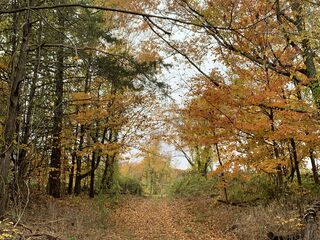Beauty
Finding Strength in Your Sacred Place
A Personal Perspective: Our special places provide safety and solitude.
Posted November 16, 2022 Reviewed by Vanessa Lancaster
Key points
- "Sacred places" connect us to our earlier selves and nurture our aspirations for the future we hope for.
- Visiting our "sacred places" might keep us grounded and refresh our hearts and minds.
Do you have a "sacred place?" A special place that connects you to the deepest parts of yourself, to your personal history, and your most dearly cherished dreams and memories?
We all need our own sacred places, whether they are in a building or a particular piece of the landscape. They often become sacred because of their associations with important events, people, or moments. They are set apart from our everyday lives and provide a safe and welcoming setting for us to be alone, think deeply, and express emotions openly. They are places where we can reflect on our lives, make sense of things, and cultivate wisdom from our reflections.
Visiting them as needed keeps us grounded and refreshes our hearts, minds, and souls. Our sacred places provide us with important connections to our earlier selves and nurture our aspirations for the future we hope for.
I have three sacred places. None of them is in a building.
Since my first overnight visit in 1981, Provincetown, Massachusetts—the tiny town at the tip of Cape Cod—has been a sacred place for me. I was 22 years old that summer, a year after I’d graduated from an evangelical college where being gay was grounds to be kicked out of school—and condemned to hellfire. My visit to “P-town” showed me openly happy gay men dancing together, holding hands on the street. It was the first place I ever felt “normal,” and it totally changed my life.
I have visited P-town regularly for the past 40-plus years to remind myself of that feeling. I have also learned to carry P-town in my heart, to remind myself as needed that embracing my truth is the key to a fulfilling life.
I first hiked to Bluff Point as a boy in the 1960s. The nature preserve in Groton, Connecticut, extends into the water of Long Island Sound. I used to go there with the boys next door. We hiked, played sports, and played around sexually—my earliest experiences. The sex seemed just another part of our friendship and set the standard for what became my ideal later in life.
When I moved “home” to eastern Connecticut in 2007, at age 48—after 30 years “away,” as New Englanders say—I rediscovered Bluff Point. It startled me to realize it had been four decades since I first went there.
Over the next 14 years, I regularly hiked, biked, and kayaked the two-and-a-half miles out to the bluff. I reflected on things going on in my life in my Moleskin notebook. I reveled in the solitude of the long sandbar beach near the bluff. It provided the escape I needed during my mom’s often challenging final years when I was her live-in caregiver.
Visiting Bluff Point became an important part of my self-care. It connected the middle-aged me with the long-ago boy I was when I first went there. It gave me a strong sense of continuity, and I marveled at how my life had brought me full circle from where I started, through many dangers, toils, and snares, back to where I began—the very place I felt I needed to escape when I went away as a teenager. Now I was back as a fully grown man who could fully appreciate the beauty and simplicity of the place where I grew up.
My third sacred place also is in Connecticut and is also a beautiful piece of landscape. It’s a big field and the woods around it in North Franklin. I first went to Franklin Swamp more than a decade ago when I began to meet up with a man who became my favorite friend with benefits and, truth be told, my long-held crush. We began as strangers hooking up through a Craigslist personal ad. Over the years, I came to value and enjoy more than ever our wide-ranging conversation, the cannabis that usually accompanied it, and the blissful benefits of our friendship in the great outdoors.

As the years passed, my special friend and our spot came to represent a powerful life-affirming force that sustained me through the leanest and lowest days of my life.
I struggled to make a living in the largely remote region where work for health/medical writers is nonexistent, and it was tough at best to stay plugged into my professional network. Talking with my friend about the struggles with money and my mom, and being able to escape them and enjoy the overwhelming sensory experience we shared, helped to keep me as balanced as I could be in those hard years.
Sometimes I would visit the swamp without my friend. I would savor its beauty, its many shades of green in the summer, and its stunning colors in the fall. I hiked in the surrounding woods, reflected in my notebook, and reveled in the intense memories of my many times there with him. I would snap photos of the field and trees, documenting their changing seasons.
I cried bitterly there after I learned in October 2014 that my dear friend I’d known since we were teens had killed himself—just like his younger brother had done many years earlier. I cried there again only a month later when I returned to bury my long-loved 18-year-old cat, Phineas. I wailed there after Mom died in October 2019.
I cried once again when I visited “my field” (as I call it) in late October of this year. “I started crying as I entered the field,” I wrote in my notebook, reflecting on “this homecoming to the place where I have brought my sorrows and tears, cried to the heavens in pain and ecstatic joy as flocks of geese flew above—and in ecstatic noises of orgasm.”
My sacred places have kept me anchored in my history and provided touchstones against which to measure my life. They connect me to events, people, and times in my life. They remind me who I am, where I come from, and what I’m about.
How about you? Do you have a sacred place? What does it mean to you? Where is it? Why is it sacred for you? When do you visit it?




